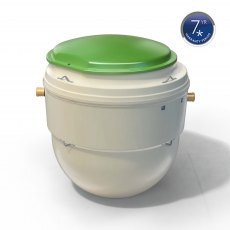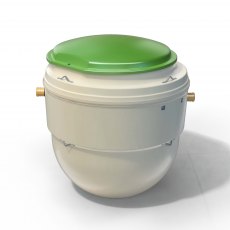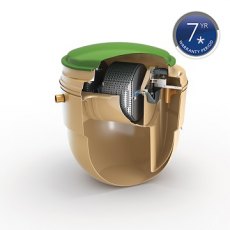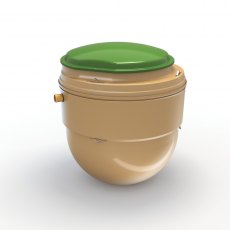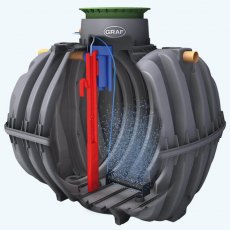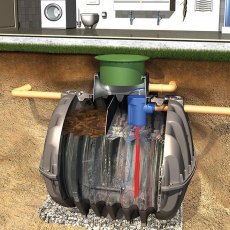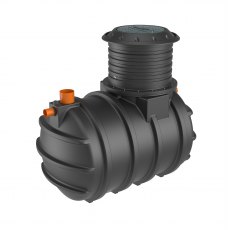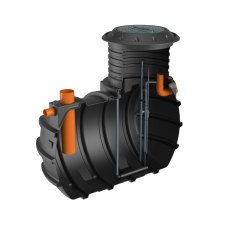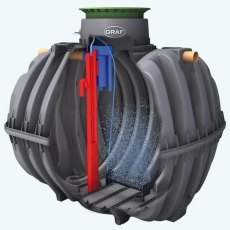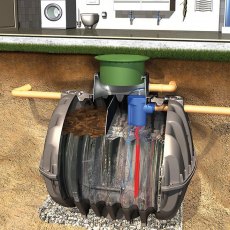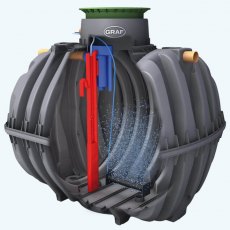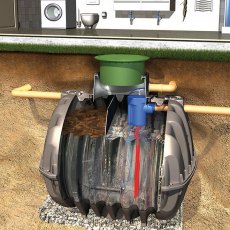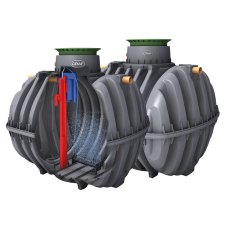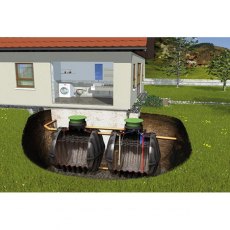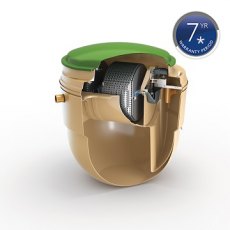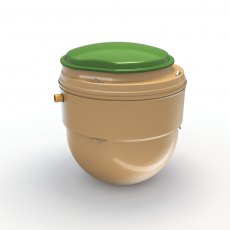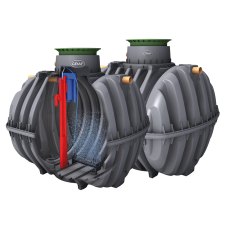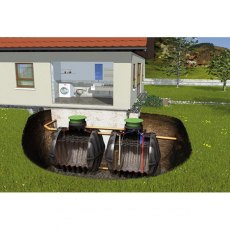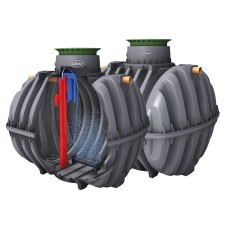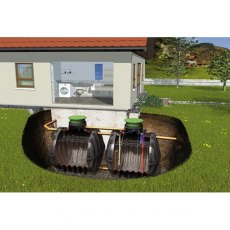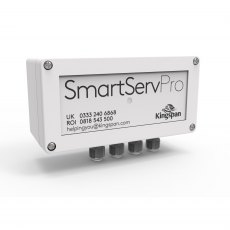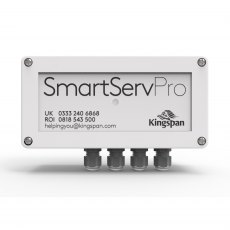Featured Products
(€5,158.23 inc VAT)
(€5,419.21 inc VAT)
Sewage Treatment Plants
To find out more about how a sewage treatment plant or wastewater treatment plants works click on Sewage Treatment Plants Explained.
To find out more about the Klargester BioDisc click on Klargester BioDisc
Sewage Treatment Plant
Sewage treatment plants are highly effective at treating waste and have very low impact. They use bacteria to remove up to 97.8% of the pollutants, before discharging the effluent into a (much smaller) drainage field. They are therefore suited to even the most sensitive sites such as close to freshwater lakes, rivers and streams - or where the water table is very high. Maintenance and running costs are relatively low for sewage treatment plants.
Sewage treatment systems work in a similar way to septic tanks, with sewage first flowing into the first chamber of the treatment plant. In this chamber, grease, oil and scum will be separated onto the top of the tank, with the solids settling on the bottom. The liquids in this chamber are moved onto a second section, where air is pumped into it to grow the amount of aerobic bacteria in this sewage, which will break down the contaminants in the water. Once this water has been cleaned, this liquid moves onto a final settlement tank, where the few remaining solids are allowed to sink to the bottom of the tank before its contents are discharged into a soakaway or watercourse.
Wastewater Treatment
There are 3 main stages for wastewater treatment.
- Sewage flows from the property into the first chamber of the sewage treatment plant. Here, the water sits until grease, oil and scum have floated to the top and solids have settled on the bottom of the tank.
- Once the process of separation has taken place, the liquid travels into a second chamber. This chamber is fitted with an air pump or blower that circulates air around the chamber to encourage the growth of aerobic bacteria. This bacteria helps to break down the contaminants in the water.
- The final stage of a sewage treatment plant is one last settlement tank. This final tank allows the very last solids that may remain to sink to the bottom of the tank before the effluent is discharged into a soakaway or watercourse. Once the treatment process has been completed, it can be discharged into a soakaway pit or water course.
Sewage Treatment Accessories
Tanks.ie also supply a large range of sewage treatment accessories and replacement parts - to go to these please click Sewage Treatment Plant Accessories.
Sewage Treatment Ireland - Tanks.ie are happy to advise you on the right type of sewage treatment plant system needed to suit Irish regulations. Please call our team on 051 351325
Sewage Treatment Plants FAQs
What is a sewage treatment plant?
A sewage treatment plant is a facility designed to treat wastewater and sewage from homes, businesses, and industries to make it safe for disposal or reuse.
What are the components of a typical sewage treatment plant?
A typical sewage treatment plant consists of several components, including a screening chamber, grit chamber, primary sediment tank, biological treatment tanks, and secondary sediment tank.
What are the benefits of installing a sewage treatment plant?
There are a whole host of benefits if you decide to invest in a domestic wastewater plant. These benefits include:
- Environmentally friendly – domestic wastewater treatment plants use natural biological processes to break down sewage and safely process harmful compounds. This reduces pollution and is vital for protecting the local flora and fauna.
- Preserves your drainage field, unlike a septic tank which only holds solids and therefore the treatment occurs in the drainage field, leading to a high risk of ground pollution. The risk of a failed soakaway is much higher with a septic tank.
- Safety – untreated sewage, or old sewage systems can release hazardous materials into your local watercourses.
- A sewage treatment plant actually treats the wastewater and you can sample it to see whether it’s working correctly.
- A long term solution - Most modern plants also have a long lifespan and are a solid investment for any property.
- Efficiency – the overall treatment process is efficient at breaking down sewage and there is a far lower chance of suffering annoying blockages.
Why is it important to have a sewage treatment plant?
It is important to have a sewage treatment plant to prevent environmental pollution, protect public health and promote sustainable water use.
Is my ground suitable for off-mains drainage?
One of the most important factors in determining the choice of sewage treatment product is the site’s drainage properties. Both septic tanks and sewage treatment plants typically require a drainage field into which they discharge effluent. Testing the ground for its permeability is usually done by a professional installer using a percolation test; the correct procedure is described in BS 6297 Note: your property will need to be located on the highly permeable ground if you want to install a septic tank otherwise the drainage field will fail.
The propensity of the site to flood and the height of the water table are also important considerations. The water table must be at least one metre below a septic tank outlet. In this instance, and if your property is in a flood risk area, you will need to install a sewage treatment plant.
What is a soakaway?
A soakaway, also known as an infiltration system, is a type of drainage system used to manage surface water runoff. It consists of a pit or trench filled with gravel, stone, or other porous materials that allow water to percolate through them and into the ground.
Soakaways are typically used in areas where the soil has good drainage characteristics, and they are often used to manage water from roof gutters, surface water drains, or other impermeable surfaces. The idea is that the water is directed into the soakaway, where it slowly percolates into the surrounding soil, reducing the amount of runoff and preventing flooding.
Do I need a soakaway for my sewage treatment plants?
A soakaway is a large hole dug into the ground, filled with stones, that manage the effluent and surface water by collecting, treating, and cleansing it, before letting it drain slowly back into the environment.
You do not necessarily need a soakaway for a sewage treatment plant – only for a septic tank. This is because the water released by a septic tank has only gone through one stage of treatment and is still hazardous to the environment. It is therefore important that water from a septic tank undergoes further treatment and cleansing in a soakaway before being safely released into the environment.
In a sewage treatment plant, the wastewater has already been through at least two stages of treatment and is therefore safe to be released directly back into the environment.
How does domestic sewage treatment work?
A domestic sewage treatment plant works by breaking down solid waste to produce a cleaner, more environmentally friendly effluent. Wastewater and sewage are supplied to the primary tank, where the solids separate and from the liquid and then flows into the biozone chamber. Here, a pump airs the waste and friendly bacteria is used to condense the organic matter, breaking it down. When the waste leaves the final waste chamber, it is 95% clean and ready for dispersal into soakaway systems, subject to consent from the relevant environmental agency.
What happens to the solid waste generated in sewage treatment process?
The solid waste generated in the sewage treatment process, also known as sewage sludge, is typically treated further through processes such as anaerobic digestion or composting, and then can be disposed of or used as a fertilizer.
Can treated wastewater be reused?
Yes, treated wastewater can be reused for a variety of purposes, such as irrigation, industrial processes, and even as a source of drinking water in some cases.
Do I need to empty my domestic sewage treatment plant?
Sewage treatment plants work by separating wastewater from solid waste in a settlement chamber. Gravity causes the heavier, solid waste to sink to the bottom of the tank so that the wastewater can be treated before being released into the environment. The solid at the bottom of the tank, referred to as sludge, builds up reducing the available volume and space in the tank for the wastewater treatment process. Your tank will become less effective and will eventually fail causing problems.
For this reason, your sewage treatment tank will need emptying periodically – a process known as desludging. How often you de-sludge your tank will depend on the type of system you have as sludge build up varies between systems. We recommend you use a registered and licensed waste collection company who will be fully insured to handle the sludge. They will visit your site, remove the sludge from your sewage treatment plant tank, and take it away for disposal.
Can I fit my own sewage treatment plant?
Although instructions are supplied with each of our products, installing a sewage treatment plant is no small feat and we do not recommend installing one yourself unless you are 100% confident you know what you’re doing. There are lots of health and safety issues to consider when excavating holes and if your sewage treatment plant is installed incorrectly you could find yourself in a nasty mess – both physically, financially, and legally.
Hiring a professional contractor to do the installation will give you complete peace of mind. Your sewage treatment plant will be installed safely, efficiently, and perhaps most importantly, it will be legally compliant. Be aware there are different rules relating to the installation of sewage treatment plants depending on whether you are based in England, Scotland, Wales, or Northern Ireland. You may need to apply for a Consent to Discharge from the Environment Agency – a licence that says that your wastewater is clean enough to release into the environment and not damage local wildlife.
Do domestic sewage treatment plants smell?
A well-maintained sewage treatment plant should not give off any bad smells. They are designed to contain any naturally occurring odours that arise during the treatment process. If your sewage treatment plant has an unpleasant odour it is important to investigate the cause.
It could be that your tank is full and needs emptying. Check the levels of sludge in your tank and arrange for the tank to be emptied if necessary.
Clogged vents could also be the cause of odours. The vents in sewage treatment plants allow toxic and flammable methane gases present in the waste to escape. Check the vent isn’t clogged with waste, snow, ice, or an animal’s nest.
Bad smells can also be caused by contamination in your sewage treatment plant. Harsh chemicals, grease or fat will all interfere with the natural enzymes in your plant that work to break down the sewage.
How long do sewage treatment plants last?
Sewage treatment plants don’t require much upkeep, but it is important to keep them properly maintained and serviced. They will need emptying periodically, a process known as ‘desludging’, by a registered and licensed waste collection company. Treat your sewage treatment plant properly and it could last up to twenty years. If they are misused or not properly maintained, their lifespan will reduce significantly.
To keep your domestic sewage treatment plant working for as long as possible, pay attention to what you are flushing down the toilet and washing down the sink. Do not flush kitchen roll, food waste, nappies, baby wipes, grease, fats and oils or sanitary products down the drain and careful with the volume of cleaning agents and detergents you are using as these can sometimes overload the system. Areas with softer water will require weaker cleaning products than hard water areas. It’s also beneficial to get your sewage treatment plant regularly serviced, where a professional will come out and inspect your system and identify any potential issues before they get worse.
What are the environmental impacts of a sewage treatment plant?
A well-designed and properly maintained sewage treatment plant can have positive environmental impacts by reducing water pollution and protecting aquatic ecosystems. However, if not properly managed, a sewage treatment plant can also have negative impacts such as odours, noise pollution and emissions of greenhouse gases. With our Klargester BioDisc we remove all these negative impacts with our top of the range sewage treatment plant.
How do commercial sewage treatment plants work?
Commercial sewage treatment plants are large-scale waste removal systems for commercial properties that are either in a rural area or can’t be connected to the public sewage network. As they are entirely independent, they use a process that breaks down the waste into a clean product that can be directly discharged directly into the environment without harming the local habitat.
They function in the same way as domestic sewage treatment plants, but are designed to cope with a much higher volume of sewage. Commercial sewage treatment plants have a motor, powered by a generator or other electrical source, that circulates air within the system. Naturally occurring bacteria use this air to break down the wastewater in the system. This destroys the harmful substances in the waste, and, after several stages of treatment, the wastewater is clean enough to be pumped into the local environment.
Initially the waste goes through a pre-treatment stage, that removes large objects and solids. The waste is then pumped into a settlement zone, where liquids rise to the top and larger substances collect at the bottom thanks to their different densities. Bacteria starts to break down harmful substances and the sludge that forms at the foot of the tank is periodically removed. The remaining liquid is then ‘cleaned’ by a process known as ‘biological treatment’, where aerobic bacteria use the oxygen circulated by the motor to break down more harmful substances. Finally, the wastewater goes through a final round of cleansing to kill any remaining harmful substances that remain. This may involve chemicals to ensure the water is as clean as possible before it’s discharged.
What’s the difference between commercial and domestic sewage treatment plants?
Commercial sewage treatment plants function in much the same way as domestic sewage treatment plants but are designed to cope with a much higher volume of sewage. Commercial sewage treatment plants can service business and commercial properties where 50 or more people go to work. In contrast, domestic sewage treatment plants would usually only deal with household waste from up to four or five people.
You’ll want to choose a commercial sewage treatment system based on the size of the premises and the number of people using the facilities. But don’t go too small! It might save you money in the short term to buy a smaller system, but if you need to upgrade to a larger system in the future it will cost you.
It is important to keep any sewage treatment plant properly serviced and maintained, but with commercial sewage treatment plants professional maintenance may be required more often and require specialty maintenance to ensure everything is working as it should.
How much do commercial sewage treatment plants cost?
Sewage treatment plants are robust and effective and offer many benefits over some other methods of sewage treatment such as septic tanks and cesspits. But how much does a commercial sewage treatment plant cost? There are several costs to consider.
The sewage treatment plant
The price of your commercial sewage treatment plant will depend on a variety of factors. Get in touch and we will listen to understand your requirements and help you choose the best plant for your commercial premise.
Cost to install
The cost of installing your commercial sewage treatment plant will depend on whether you’re installing a brand new system or upgrading an existing one, as well as which plant you have chosen and where the plant is being installed.
Annual service
You’ll need an annual service to ensure the ongoing performance of your commercial sewage treatment plant. The cost will depend on your equipment and location.
Emptying
Sewage treatment plants need to be periodically ‘de-sludged’.
What are the 3 types of sewage treatment?
- Primary wastewater treatment
The primary treatment of wastewater removes material that will either float to the top or settle to the bottom. The wastewater is temporarily held in a settling tank where the heavier solids sink to the bottom and lighter bits float to the surface. Once settled, these solids are held back while the rest of the liquid is moved through to the secondary phase of wastewater treatment.
- Secondary wastewater treatment
A deeper and more rigorous secondary phase of wastewater treatment uses aerobic biological processes to substantially degrade the biological content of the waste, reducing common biodegradable contaminants down to safe levels. There are three ways to do this: biofiltration that uses filters to ensure that any additional sediment is removed from the wastewater, aeration which increases oxygen saturation by introducing air to wastewater and oxidation ponds that allow wastewater to pass through natural bodies of water for a set period before being retained for two to three weeks.
- Tertiary wastewater treatment
Tertiary wastewater treatment aims to improve water quality to meet domestic and industrial standards. It involves removing pathogens to ensure water is safe for drinking
What is the difference between a septic tank and a sewage treatment plant?
Although the two are often mistaken as the same thing, there are some distinct differences between the two. A sewage treatment plant creates a clean, environmentally friendly effluent which can be discharged directly to a watercourse. They often require electricity to operate and need regular servicing and emptying. A septic tank only needs emptying once a year, doesn’t use any electricity and doesn’t require servicing. However, they produce a very polluting waste product, which must be dispersed to a soakaway and the septic pollutants go through further handling by the natural aerobic soil bacteria.
How I do install a sewage treatment plant?
It is strongly recommended that a suitably trained and qualified professional installs your sewage treatment plant. You could be faced with hefty repair costs, fines and even legal issues (that will be far greater than the cost of hiring a professional installer) if any part of your private sewage system is installed incorrectly. If you are confident you have the skills to do this yourself you should have step by step instructions on how to do it from the manufacturer of your chosen tank, plus all the health and safety measures that should be taken. The following will give you a brief guide on what will be involved in the install, but always ensure you adhere to the manufacturer’s guidance as some steps may vary.
- Inspect tank for damage
Although our tanks will have been fully tested and checked before being dispatched to you, make sure to thoroughly inspect the tank for any damage caused during transportation as, once the tank is installed, we may not be able to accept your return.
- Placing the tank
Ensure your hole is large enough for the both the tank and the recommended backfill. Prepare a base for the tank and carefully lower the tank into the hole, using the recommended lifting system, checking that the inlet and outlet orientation is correct. Ensure your tank is level and use the correct backfill, which might be concrete, gravel or sand, but check the manufacturer’s manual to see what they advise and follow their steps for adding the backfill.
- Installing the inlet and outlet
Installing the inlet and the outlet should be straightforward, but it is always worth contacting a qualified plumber if you are unsure. Follow the manufacturer’s installation guide to connect the pipework. For easier maintenance access, some manufacturers advise the install of an inspection chamber before and after the treatment to make life easier should any problems arise in the future.
- Wire up the electrics
All electrical work should be conducted by a qualified electrician. The installation manual will detail what is required.
This is a very simplistic guide of what is required to install your sewage treatment plant. In addition to these steps, you may also need to install a soakaway to complete your system.
How do I need to prepare to install my sewage treatment plant?
It is highly recommended that you fully understand and adhere to all the regulations that will affect your installation and running of a sewage treatment plant. If you are the property owner where the tank is being installed, this is your sole responsibility and you could be liable to heavy fines or repair costs if things are done incorrectly.
Invert Depth, what is this?
It is the level of the soil pipe entering the septic tank or treatment system.
Gravity or IPS, what is the difference and when would I need them?
If the flow from your system can not release without help, i.e. required to be uplifted you would need a pump to help with this.

 Login
Login

